
Everything in this slideshow
-
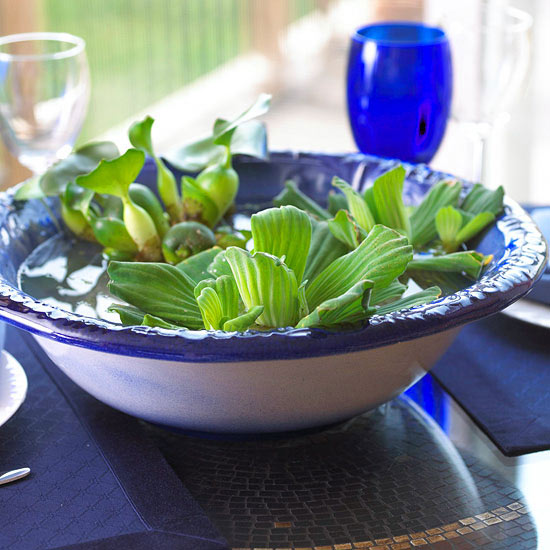
Start Small with Landscape Water Features
Sure, water features can be big and bold, but they can also be sized to better fit your space and your gardening time. For example, try your hand at tabletop water gardening for a simple splash of water gardening in a busy life or small area. Here, a few succulents and water lettuce are tucked in a small ceramic bowl. Move the mini water garden from a sunny spot to the dining area when you need a quick, no-cost focal point.
Best For: Beginning water gardeners looking for tabletop accents, a touch of nature, and low maintenance in a confined space. These spare-time water features are ideal projects for balconies, small decks, and other intimate dining or sitting areas.
- If you plan to add fish to your water feature, find care and feeding tips.
-
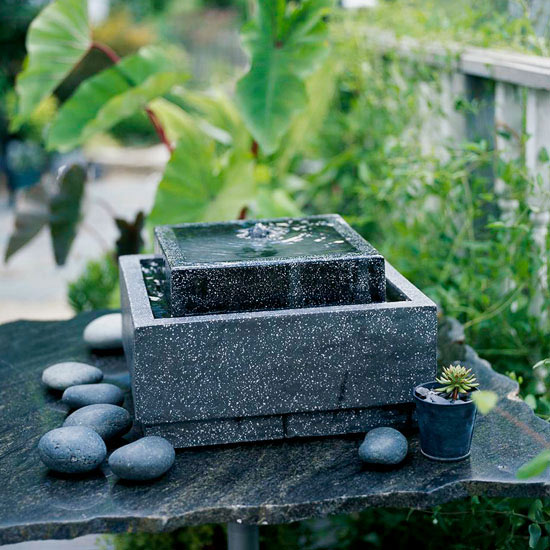
Focus on Style
Small-scale water features can accent the design aesthetic of an intimate space in the same way that a big water feature fits into the design continuum of a bigger yard. A geometric two-tier water feature accentuates the clean lines and contemporary Asian influence in this outdoor space.
Best For: Gardeners looking for style and flexibility with low time and maintenance commitments. Ready-made tabletop and patio-size water features are readily available in an assortment of design styles. Most are relatively simple to install and maintain.
-
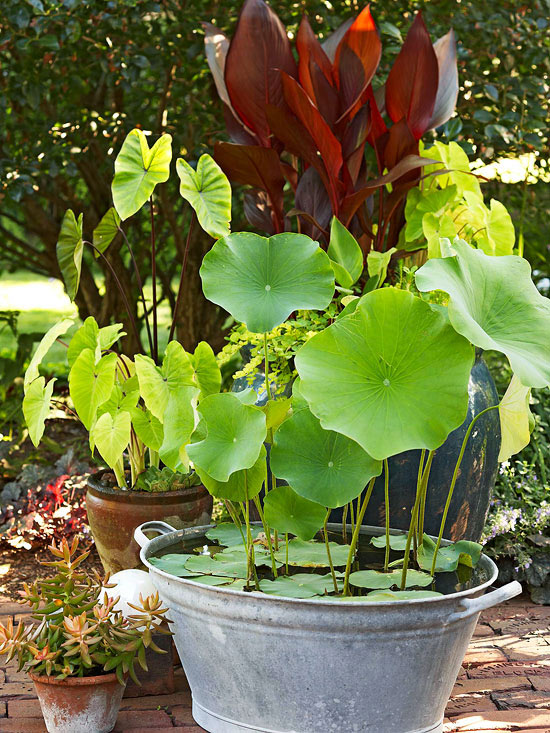
Explore Unusual Containers
Water features lend themselves to virtually any kind and style of container, including oversize galvanized tubs. The containers must, of course, be watertight. Large-scale containers such as these can support large-scale plants, adding height and structure to a landscape water feature. Group a few complementary containers of various sizes for a striking water-feature focal point.
Best For: Gardeners with a flair for reimagining. An ability to see a container from a different perspective creates a water feature with style to match the garden’s sensibility. Once installed, these projects become easy-to-maintain garden centerpieces.
-
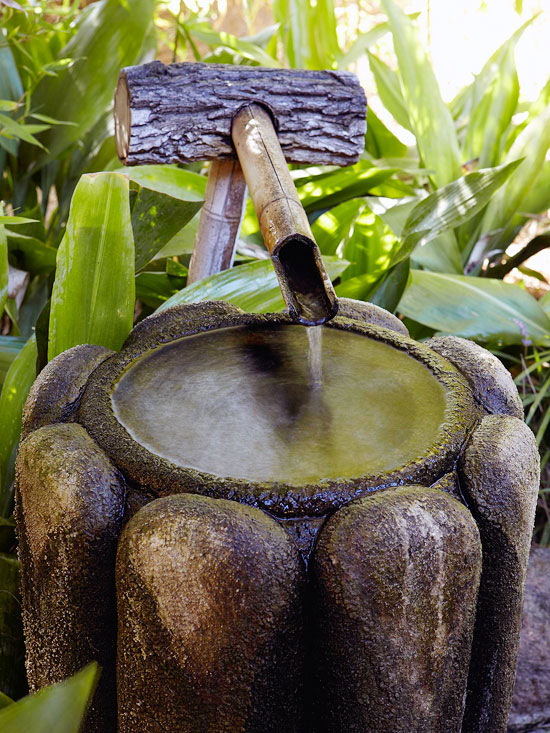
Design a One-of-a-Kind Fountain
Unusually designed water features can integrate seamlessly into a landscape. The key is to use elements in the fountain that complement the shape, texture, and style of the garden. How you combine elements — basin, pedestal or base, and spout — determines the sense of style. Here, gently rounded stone edges and a spout fashioned from bamboo and bark help this fountain blend with the Asian-inspired landscape around it.
Best For: Gardeners with a willingness to explore options and materials. A relatively fuss-free garden accent, a fountain that’s unique to its garden setting takes a bit of thought, research, and imagination to create.
- Explore landscape fountain ideas.
-
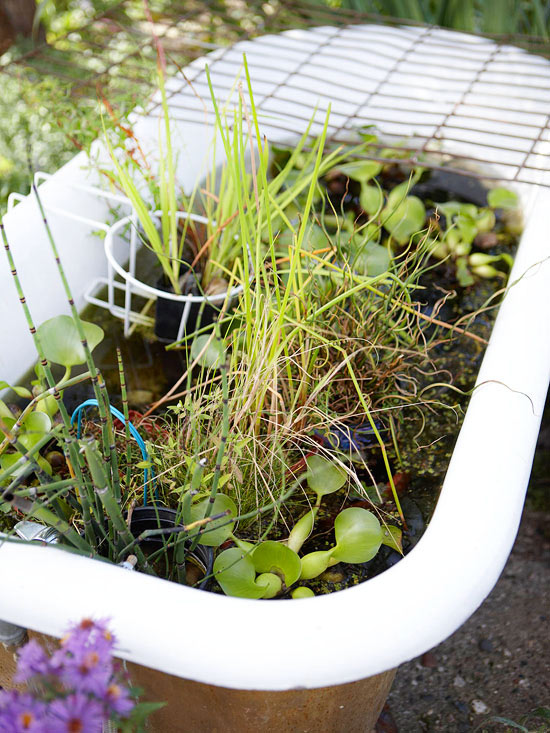
Reuse Cast-Off Items
If your outdoor style tends more toward the eccentric end of garden design, then your water feature can be a bit idiosyncratic, too. With larger containers, you’ll be able to include a wider variety of plants, such as the collection nestled in this vintage claw-foot tub, to create color variation, height, and texture in your focal-point water feature. Seeing beyond an object’s original use to envision its potential can create a delightful garden attention-getter.
Best For: Gardeners with a desire for the unexpected and a preference for the avant-garde. Repurposed materials imaginatively converted to landscape water features become conversation pieces.
-
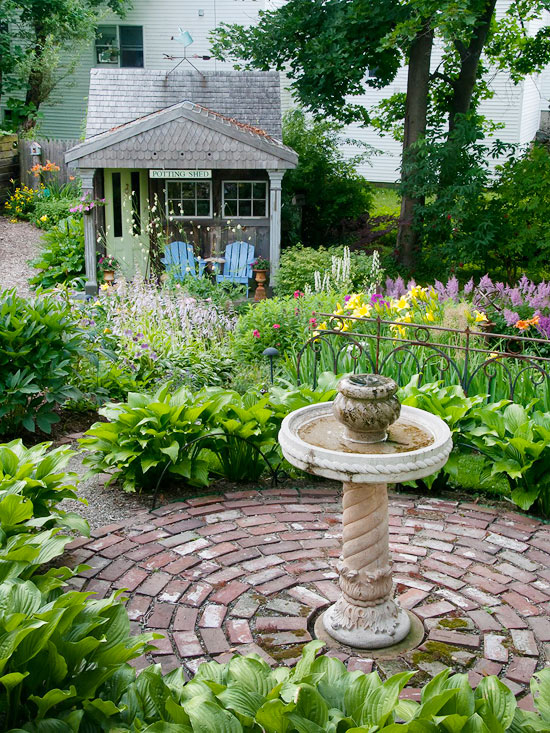
Use a Birdbath as a Focal Point
Landscape water features include birdbaths and stand-alone fountains; some have moving water elements, while others highlight stationary pools. Placed in a circular paved area, a bubbling or still water feature such as this birdbath can act as a yard’s organizing focal point. A birdbath can be a focal point in a structured formal garden, on a deck, in a blowsy cottage garden, and in all sorts of garden incarnations when it’s surrounded by plants and hardscape suited to the desired style.
Best For: Gardeners looking for a focal point and wildlife. A birdbath offers a simple structure on which to build a design. Provide appropriate shelter and food sources in the garden mix to attract birds and wildlife.
-
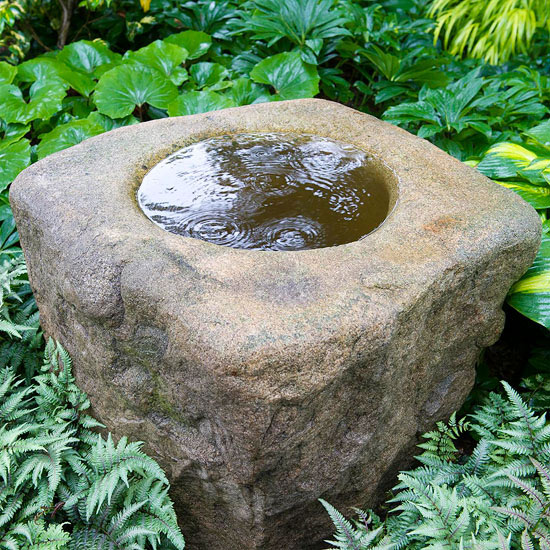
Choose a Natural-Looking Landscape Water Feature
In autumn and winter when the rest of the garden dies back, a water feature such as this fountain nestled in a boulder adds beauty and structure to an outdoor space. Keep all-season appeal in mind when choosing the placement and size of a water feature, particularly if the material can withstand the elements. Even if the water is drained in the winter, the water feature can be a beautiful sculptural element.
Best For: Gardeners who prefer all-season interest. A water feature with naturalistic ambience acts as a focal point when foliage is less prominent and a subtle accent when the garden is in bloom.
-
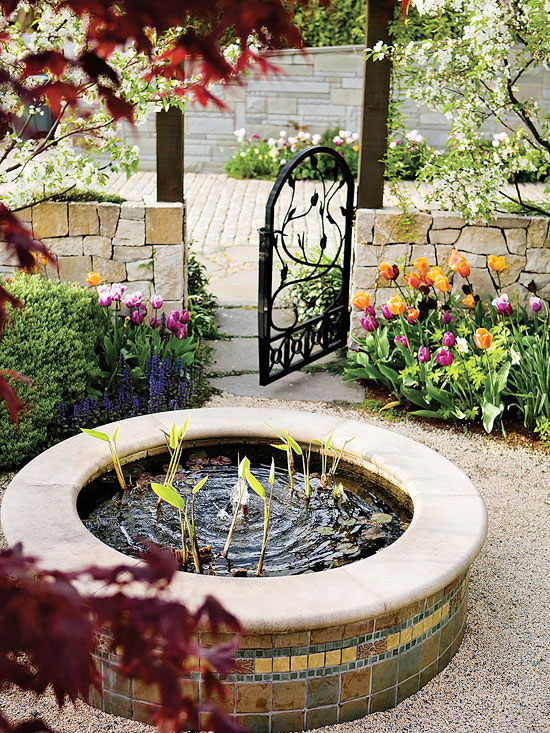
Include a Stand-Alone Pond
A small stand-alone pond on a patio or deck or in a garden niche can be an interesting architectural feature. A bonus: It can be a less-expensive way to start working with water plants and perhaps even a few fish. Here, the edge of the water feature is wide enough to provide seating, too.
Best For: Gardeners who want to delve into water-garden possibilities but at a manageable level. A self-contained pond requires more maintenance but also offers more garden opportunities.
- See the best plants for your water garden.
- Know your pond fish.
-
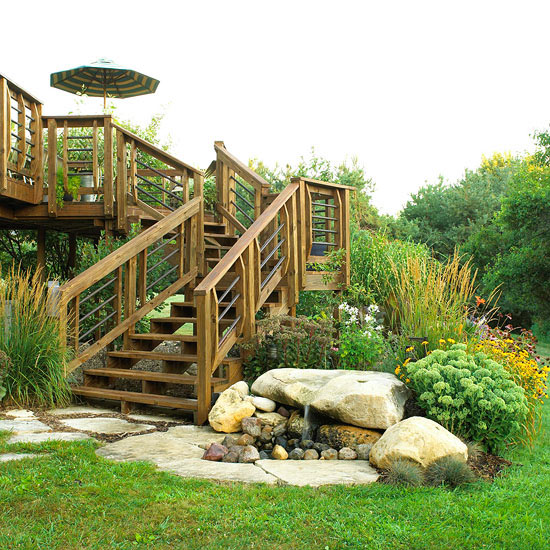
Use a Small Waterfall as a Flowerbed Accent
As a terminus, a small water feature such as this waterfall is a good way to taper off and dramatically end a flowerbed. Here, the large-boulder collection signals a stopping point for the planted area that rings the back patio; it also encourages visitors to stop and admire both the stream and the flowers. The sound of falling water adds a pleasing element to the nearby deck.
Best For: Gardeners who want the sound and structural appeal of flowing water but not necessarily water plants. A small waterfall can be surrounded by plants but need not include water plants.
-
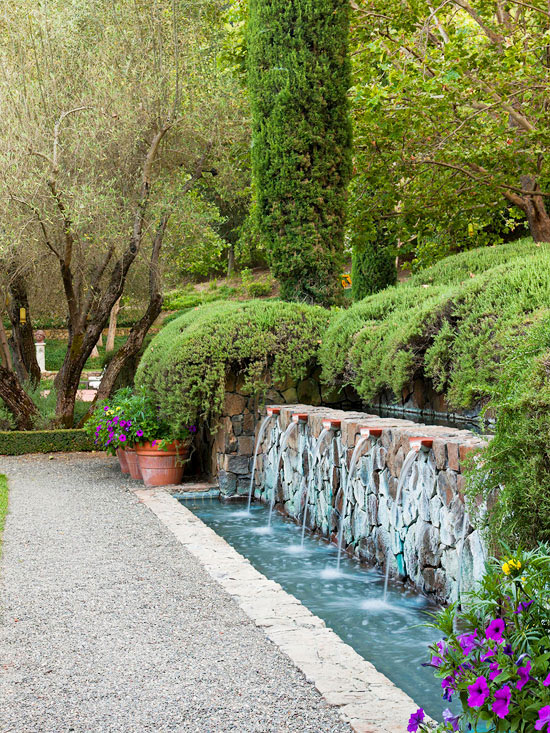
Add Drama to a Retaining Wall
Water features don’t have to include plants or fish. The sound of water and the drama of design can be enough for some gardeners and gardens. This water feature — cleverly used as both retaining wall and focal point — repeats the classic shapes and materials in the rest of the outdoor space.
Best For: Gardeners whose focus is design with water. Pools and fountains along a wall are all about the look and sound.
-
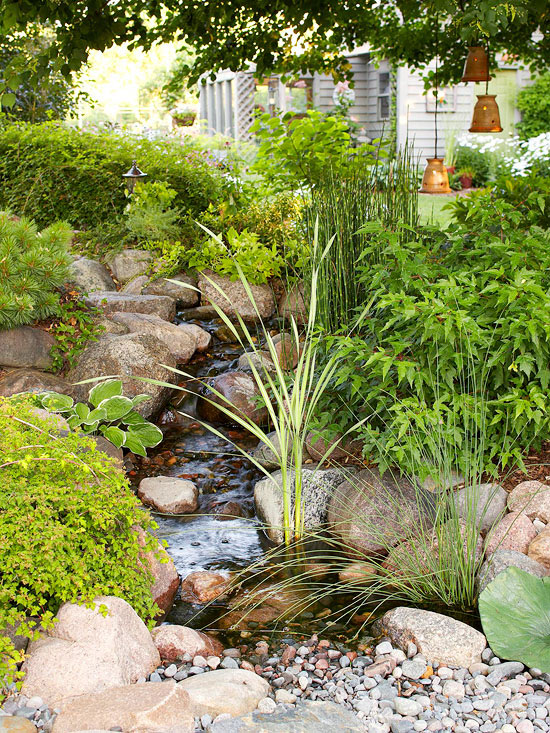
Enlarge a Stream
Especially for larger backyards with naturalistic design, a stream can be a great way to extend a water feature and add an expansive sense of exploration to an outdoor space. The water feature needn’t be overly wide — this one spans just over a foot — but it can use both hardscape pieces such as boulders and a variety of plants to meld it with the surrounding landscape.
Best For: Gardeners who want to emulate the pleasure of a woodland stream. As it trickles and gurgles along, a landscape stream can guide visitors to secret niches and resting spots.
-
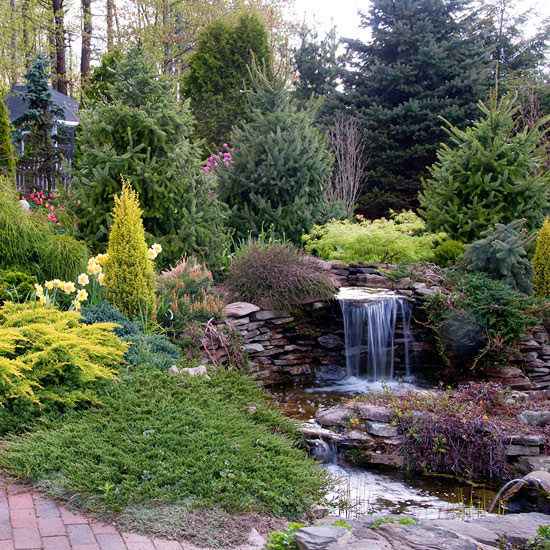
Use a Water Feature to Conquer a Slope
Integrating a water feature is an effective way to manage a slope. Depending on the size of the slope and the yard, the water feature can contain several levels; this one is stepped down with a waterfall and two levels of ponds. Working with flagstone as a retaining wall helps the water feature feel more natural in this setting, as does the combination of evergreens and blooming plants.
Best For: Gardeners who want to take advantage of water’s natural properties. Because water wants to flow downhill anyway, pools, streams, and waterfalls are ideal for changing a hillside from a problem to a pleasure.
- Get tips for taming a slope.
-
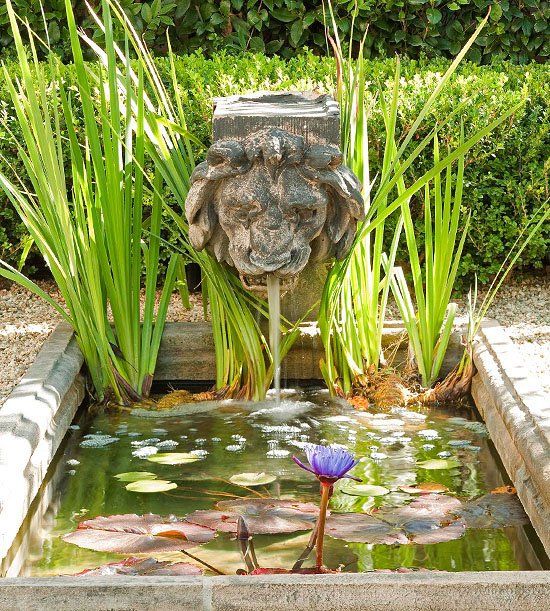
Create a Small In-Ground Pond
In-ground ponds can be subtly integrated into the landscape or distinctly set apart in a more formal style. Either way, they offer a chance to include water plants as well as a fountain. An in-ground pond can be designed in any size and shape to match a garden style. Here, pavers and gravel surround the sculpted stone sides of this small focal-point pond. A formal trimmed hedge provides a suitable backdrop for the spurting-lion fountain.
Best For: Gardeners who want custom style. With water plants, a suitable fountain, and coordinating landscaping, an in-ground pond creates a complete water feature.
- Learn more about water-garden care.
-
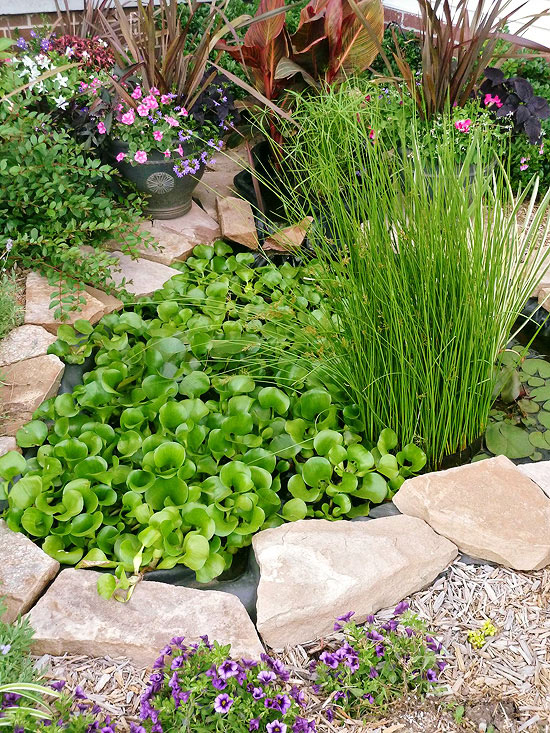
Keep a Pond Simple
With ready-to-assemble kits and the wide availability of water plants, a water feature can be simple to install and maintain. Here, just a trio of plants fills this small pond. A casually loose arrangement of stones borders the pond, and low-growing plants soften the edges.
Best For: Gardeners who want all the advantages of a water garden without too many headaches. Ready-made forms offer relatively simple installation in sizes that make maintenance manageable.
-
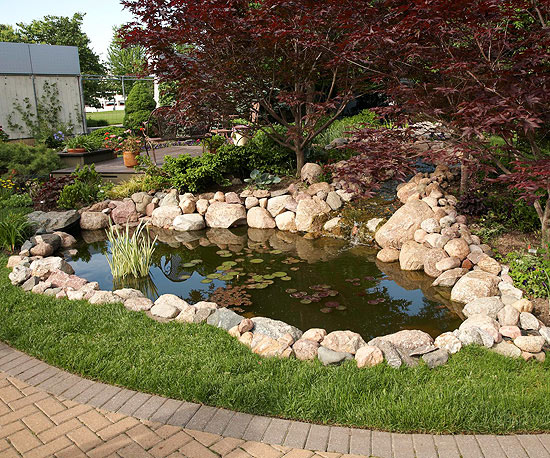
Expand Your Current Water Feature
If you’ve tackled a small fountain, container water garden, or pond, you might be ready to integrate a larger water feature, such as a stream-pond duo, into your landscape. Here, a small brook leads to the boulder-edge pond; just a few plants dot the surface. Placed along a path, a pond provides a stopping point for visual interest.
Best For: Gardeners who are ready for a more complex project. Integrated water features with streams, pools, fountains, falls, plants, fish, and other elements require significant planning and weekly maintenance.
- See how a water feature changes the landscape.
-
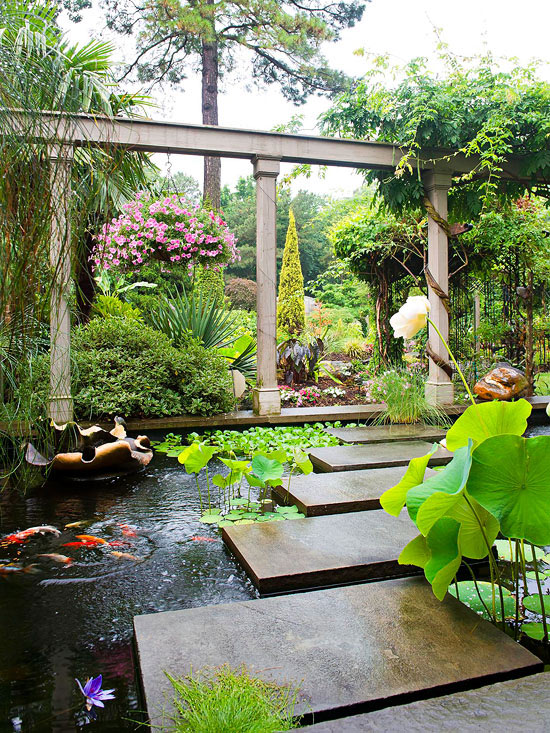
Interact with a Large Pond
The edges of a pond can certainly be static, but clever arrangement of hardscape elements can make a water feature a more hands-on experience. Here, large rectangular slabs provide a walking surface across the water, breaking up the expanse without dividing it. That enables gardeners and visitors to change their vantage points to appreciate the pond’s varied beauty and incorporate the views and activity into their lifestyle.
Best For: Gardeners who dream of a stylish, large-scale water feature. An expansive water feature can fill the garden with pleasing design elements that accentuate the appeal of the outdoor living spaces.
- Check out these inspiring water-garden ideas.
-
